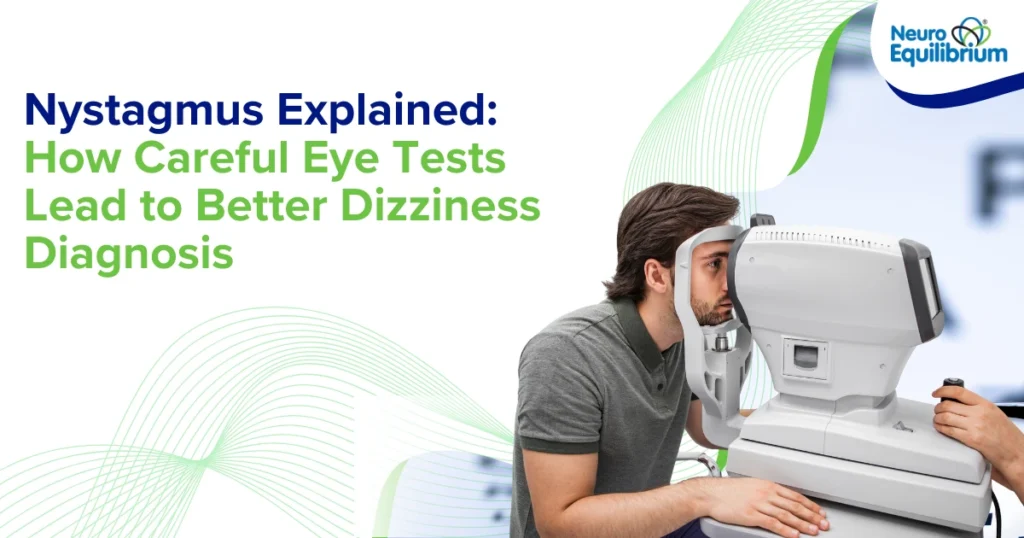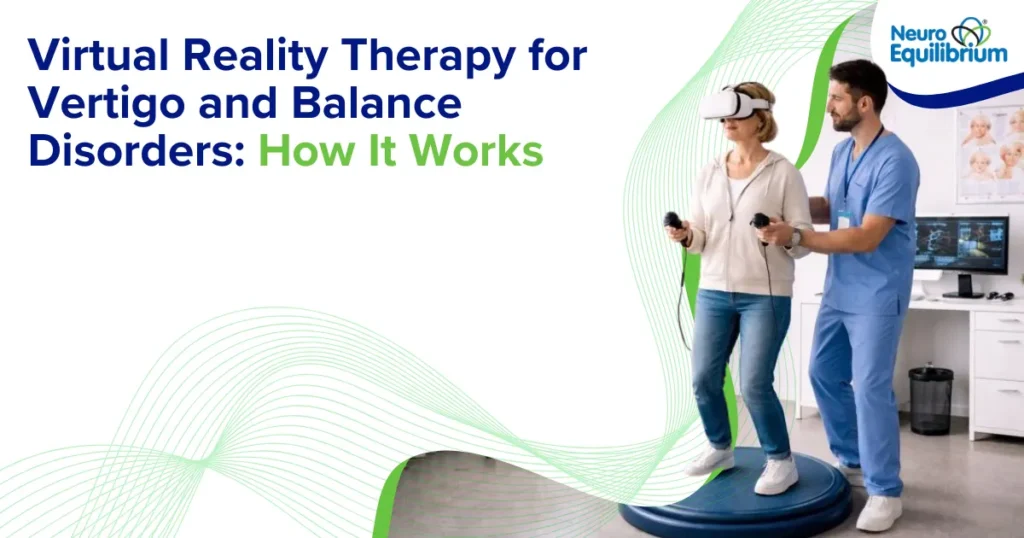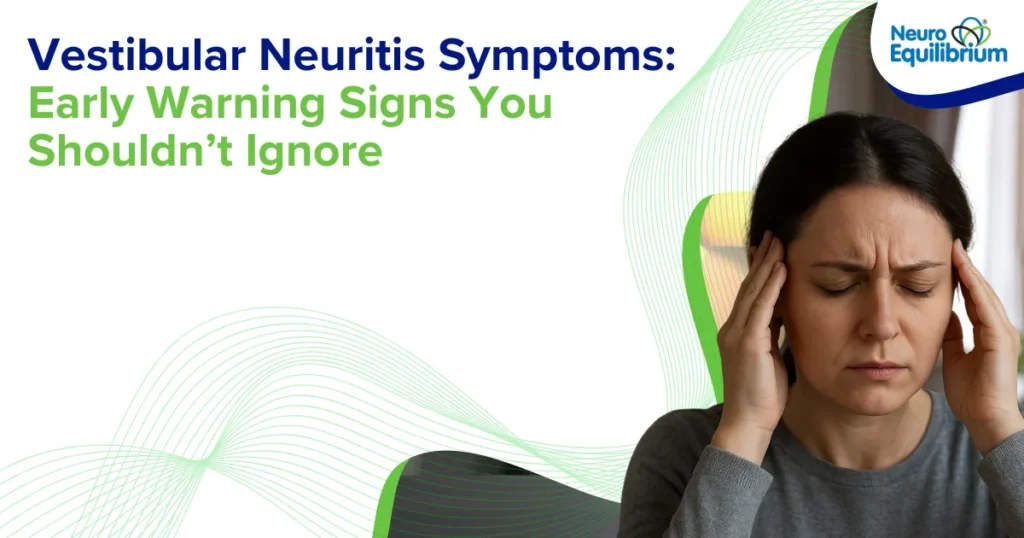If you’ve ever felt lightheaded and gone from doctor to doctor without finding an answer, you’re not alone. Most patients are in that boat. They are aware that they have been diagnosed with nystagmus but frequently there is no description of what this actually means. A straightforward and clear explanation can go a long way. The absence of these details may make you feel anxious, confused, and uncertain of what to do next.
Dizziness may be caused by a plethora of factors, and one of them may lie in the eyes. Doctors will usually seek an eye movement referred to as nystagmus to determine what might be causing your balance problems. The trick is that in the majority of medical records, the word nystagmus appears with no further explanation. It is much like saying that a patient is in pain without specifying where or what type of pain. Such a lack of detail may result in critical information being missed and this may result in delays, misdiagnosis or incomplete treatment.
What Is Nystagmus?
Nystagmus is a term used to describe involuntary eye movements that happen beyond your control. The eyes tend to move in a rhythmic pattern, and quite a few people aren’t even aware it’s happening. Medical professionals look for this movement because it provides important clues about how your inner ear and brain are working together to help you stay balanced.
Experts describe nystagmus as a repeating eye movement, which always has at least one slow phase. When the movement includes both a slow and a quick phase, it’s called jerk nystagmus. If the eyes swing back and forth only through slow movements, it’s called pendular nystagmus.
Doctors may also describe nystagmus based on three things:
- Direction – whether the eyes move side to side, up and down, or in a twisting motion.
- Timing – whether it happens at rest, when lying down, or only during certain head movements.
- Duration – whether it fades after a few seconds or continues without stopping.
These details matter because they help identify the cause of dizziness. For example, a short-lasting nystagmus that appears when you lie down can point to a common and treatable inner ear condition. A nystagmus that continues without fading may suggest that the problem lies in the brain. This is why simply writing “nystagmus” in a medical record without explaining what type it is does not give enough information for proper diagnosis.
Know More About Dizziness
- Is Your Dizziness Labyrinthitis or Something Else?
- What Happens When Dizziness and Blurry Vision Come Together?
- Neck Pain Causes That Can Lead to Dizziness – Should You Be Worried?
Why Nystagmus Matters in Dizziness Diagnosis
When you visit a clinic for dizziness, one of the doctor’s main goals is to find out where the problem is coming from. It may be the inner ear (the balance system), the nerves that carry balance signals, or the brain.
Nystagmus gives doctors a direct clue about this. By watching how your eyes move, they can tell whether your dizziness is linked to the inner ear (a peripheral balance problem) or to the brain (a central problem). They can also figure out which side is affected and whether the condition is harmless and temporary or something that needs urgent attention.
For example, some inner ear conditions cause nystagmus that comes in short bursts and fades quickly. Other problems, such as inflammation of the balance nerve, cause nystagmus that continues in one direction without fading. More serious brain-related causes, such as a stroke or multiple sclerosis, may create unusual or vertical eye movements.
In this way, nystagmus works like a map of your balance system. If the map is incomplete because the eye movements were not described in detail, patients may be given the wrong explanation and the wrong treatment.
| Aspect | Inner Ear (Peripheral) | Nerve (Vestibular Nerve) | Brain (Central) |
| Source of Problem | Balance system inside the ear | Pathway carrying balance signals to brain | Brain centers that control balance |
| Role of Nystagmus | Shows if dizziness is ear-related | Indicates abnormal continuous signals | Suggests brain-related causes |
| Examples of Conditions | Benign inner ear problems (e.g., BPPV) | Vestibular neuritis (nerve inflammation) | Stroke, multiple sclerosis, or other brain lesions |
| Clinical Importance | Helps identify which side is affected | Differentiates nerve involvement from ear | Points to urgent/serious conditions |
| Risk if Not Described Well | Wrong diagnosis or treatment | Misinterpretation of source of dizziness | Missed urgent brain-related cause |
Common Gaps in Routine Examinations
Many medical records mention nystagmus simply by name, often leaving out important details. When a doctor sees something noteworthy but does not record it, it can lead to confusion later on, as another physician reading the file might find the information vague or incomplete. This can lead to frustration, extra visits, and unnecessary tests.
The Role of Frenzel Goggles and Proper Examination Techniques
One common reason nystagmus is missed or misdiagnosed is that tests are sometimes done without the right equipment, especially Frenzel goggles.
Frenzel goggles are special magnifying glasses with built-in lights. They prevent patients from focusing their gaze, which can hide nystagmus. The goggles also make the eyes appear larger, so even the smallest movements are easier for the doctor to see. This helps in identifying the direction, strength, and pattern of nystagmus much more accurately.
In the absence of Frenzel goggles, the brain may mask these eye movements at times, such that it appears nothing is wrong. Together with the Frenzel goggles, there are other modern equipment, including video-oculography and infrared recording of eye movements, which enable specialists to document and analyze the details of eye movements.
How Careful Eye Tests Improve Your Diagnosis
When nystagmus is carefully described and measured, it can truly transform the way dizziness is diagnosed and treated. Detailed eye testing provides valuable insights, helping doctors pinpoint whether the issue stems from the inner ear or the brain. This step is essential and sets the foundation for choosing the most effective treatment. By noting details like the direction of eye movement and whether it fades, doctors can avoid confusion between different conditions, such as balance problems from the inner ear or more serious brain-related issues like stroke.
Effective testing also streamlines the process by reducing unnecessary scans or visits. Sometimes, simply observing the eye movements closely can lead to the right diagnosis in most cases. This allows healthcare providers to act quickly, whether through simple exercises, medications, or referrals to specialized neurological programs. Ultimately, this approach means fewer uncertainties, fewer repeat visits, and a much smoother path to recovery for patients.

What Patients Should Ask Their Doctor
Living with dizziness can be overwhelming, especially if past explanations have been unclear. Asking the right questions can help you take an active role in your care and make sure nothing important is missed during your consultation.
The other significant question is how the nystagmus observed is related to the symptoms you are experiencing. Such a discussion will not only clarify your condition, but will also motivate your doctor to explain it more clearly and in a detailed manner. As a patient, you are within your right to know what is being measured and how it relates to your diagnosis.
The NeuroEquilibrium Advantage
At NeuroEquilibrium, we believe every dizziness diagnosis should be thorough and complete. That’s why we use top-notch diagnostic tools like Frenzel goggles, video-oculography, and infrared eye-movement recordings. Our experienced team carefully records the exact direction and pattern of nystagmus, noting whether it disappears or persists, and we connect these findings with your symptoms.
This careful approach ensures you won’t find vague entries like nystagmus in your medical records without details. Instead, you’ll leave with a clear understanding of what’s happening, why you’re experiencing dizziness, and what steps can be taken to help. Whether it’s you or someone you care about facing dizziness, NeuroEquilibrium has the answers, the confidence, and the compassionate care you deserve. Scheduling a consultation is a positive first step toward lasting relief and improved balance.
Sources
- Sekhon R.K. (2023). Nystagmus — Types, Etiology, and Clinical Features. StatPearls. https://www.ncbi.nlm.nih.gov/books/NBK539711/ (NCBI)
- Physio-Pedia. (n.d.). Nystagmus. https://www.physio-pedia.com/Nystagmus (Physiopedia)
- NCBI / MSD-Manuals. (2025). Nystagmus — Ear, Nose, and Throat Disorders. https://www.msdmanuals.com/professional/ear-nose-and-throat-disorders/inner-ear-disorders/nystagmus (MSD Manuals)
- MedlinePlus. (2023). Videonystagmography (VNG) — Medical Test & Vestibular Diagnosis. https://medlineplus.gov/lab-tests/videonystagmography-vng/ (MedlinePlus)
- MedlinePlus. (2023). Balance Tests: Diagnosing Balance & Dizziness Disorders. https://medlineplus.gov/lab-tests/balance-tests/ (MedlinePlus)
- Core publication. (2023). Vertigo in Clinical Practice: Evidence-Based Diagnosis & Management. NCBI Bookshelf. https://www.ncbi.nlm.nih.gov/books/NBK482356/ (NCBI)
- Physiological overview. (n.d.). Vestibular Nystagmus & Vestibulo-Ocular Reflex (VOR). ScienceDirect / medical textbook. (ScienceDirect)
- Interobserver agreement using eye-movement recordings https://pubmed.ncbi.nlm.nih.gov/40820099
- Telemedicine video-recording diagnosis of BPPV https://pubmed.ncbi.nlm.nih.gov/40217944/
- Supine Roll Test / nystagmus patterns in hc-BPPV https://pubmed.ncbi.nlm.nih.gov/35711266
What is nystagmus and how does it relate to dizziness?
Nystagmus is involuntary rhythmic eye movement. Looking at it helps doctors determine if dizziness is coming from the inner ear or the brain.
Why do doctors need to record the direction and type of nystagmus?
The path, speed and exhaustibility of the nystagmus are the major indicators that can help differentiate between the BPPV, vestibular neuritis or central neurological causes.
What are Frenzel goggles and why are they important?
Frenzel goggles are special magnifying glasses with built-in lights that prevent patients from focusing their gaze. They make even subtle eye movements visible to doctors, which is essential for detecting nystagmus accurately.
Can eye tests replace scans and other expensive tests for dizziness?
Dizziness can be caused by a variety of factors, many of which can be identified with careful eye examination with the use of proper tools, which saves time and money without having to repeat any scans.
What should patients ask their doctor about nystagmus?
The patients are guided to ask what type of nystagmus, the direction, whether the nystagmus resolved or not, and whether a more advanced test, like video-oculography or infrared was performed.
















